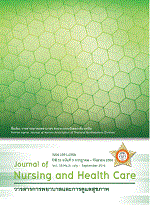ปัจจัยทำนายระดับความเสี่ยงต่อการเกิดโรคหลอดเลือดหัวใจ ใน 10 ปีข้างหน้าของผู้สูงวัยชาวชนบท Predictors of The Ten-Year Risk Level for Developing Coronary Heart Disease in Rural Older Adults
คำสำคัญ:
ความเสี่ยงต่อการเกิดโรคหลอดเลือดหัวใจ ผู้สูงอายุ สุขภาพชุมชนชนบท coronary heart disease risk, older adults, rural healthบทคัดย่อ
ผู้สูงวัยเป็นกลุ่มเสี่ยงสูงต่อการเกิดโรคหัวใจและหลอดเลือด การวิจัยเชิงสำรวจแบบภาคตัดขวางนี้มี
วัตถุประสงค์เพื่ออธิบายปัจจัยทำนายระดับความเสี่ยงต่อการเกิดโรคหลอดเลือดหัวใจใน 10 ปีข้างหน้าในกลุ่มผู้สูงวัย
กลุ่มตัวอย่างจำนวน 400 รายจากผู้สูงวัยทั้งหมด 1,465 ราย (ร้อยละ 27.3) อาศัยอยู่ในชุมชนชนบทแห่งหนึ่งในภาคใต้
ประเมินระดับความเสี่ยงต่อการเกิดโรคหลอดเลือดหัวใจตามเกณฑ์ Framingham Global Risk Scoring วิเคราะห์
โมเดลทำนายระดับความเสี่ยงจากชุดตัวแปรปัจจัยเสี่ยงหลักร่วมกับปัจจัยเสี่ยงรองโดยใช้สมการทำนายโลจิสติก
ผลการวิจัย พบว่า ผู้สูงวัยมากกว่าครึ่ง (ร้อยละ 54.5) มีความเสี่ยงต่อการเกิดโรคหลอดเลือดหัวใจระดับ
ค่อนข้างสูงหรือสูง กลุ่มของปัจจัยเสี่ยงหลักสามารถทำนายระดับความเสี่ยงได้ร้อยละ 82 เมื่อวิเคราะห์โดยเพิ่ม
ปัจจัยเสี่ยงรองทั้ง 3 กลุ่มเข้าไปในโมเดล พบว่า มีอิทธิพลในการทำนายเพิ่มขึ้นเป็นร้อยละ 83.3 โดยในกลุ่มปัจจัย
เสี่ยงรองนี้ ไขมัน ไตรกลีเซอร์ไรด์ ไขมันแอลดีแอล ดัชนีมวลกาย และเส้นรอบเอว สามารถทำนายระดับความเสี่ยง
ได้อย่างมีนัยสำคัญทางสถิติ ในการป้องกันและลดความเสี่ยงต่อการเกิดโรคหลอดเลือดหัวใจโคโรนารีในผู้สูงอายุนั้น
ทั้งบุคลากรทางการแพทย์ และผู้สูงอายุจะต้องตระหนักถึงความเสี่ยง และปัจจัยเสี่ยงของการเกิดโรคหลอดเลือด
หัวใจ โดยจัดการปัจจัยเสี่ยงหลักและรอง ซึ่งได้แก่การควบคุมระดับความดันโลหิต ระดับนํ้าตาลในเลือด ระดับไข
มันโคเลสเตอรอล ระดับไขมันไตรกลีเซอร์ไรด์และไขมันแอลดีแอล ร่วมกับการเพิ่มระดับไขมันเอชดีแอล และการ
ควบคุมนํ้าหนักตัวโดยการออกกำลังกายและควบคุมอาหาร
Older Adults are at risk of developing coronary heart disease (CHD). The objective of this descriptive, cross-sectional study was to examine whether the major and minor risk factors predicted the risk level for developing CHD in rural older adults. Participants were 400 (27.3%) of the total 1,465 elder people at a rural community in the south. Coronary heart disease risk levels were classifi ed based on the Framingham Global Risk Scoring algorithms. Logistic regression analysis was used to develop a predictive model of
the CHD risk level from major and minor risk factors. Results found that more than a half (54.5%) of the older adults had a moderate to high risk for the developing CHD. The major risk factors model was accounted for 82% of the variance explained on the risk for CHD development. When the three groups of minor risk factors were added to the major risk
factors model, the variance of the predictive model was increased to 83.3%. Triglyceride, LDL, body mass index, and waist circumference were added signifi cantly. In order to reduce the risk for CHD in elderly people, both clinicians and older adults must be aware of the risk of CHD development. CHD prevention program in older adults should be targeted to reduction of these minor and major risks, that is, blood pressure control, lowering plasma glucose, and lowering cholesterol, triglyceride and LDL. Increasing HDL and weight control by exercise and diet control are recommended.



